Model Predictive Direct Speed Control of Permanent-Magnet Synchronous Motors with Voltage Error Compensation
Abstract
1. Introduction
- (1)
- The trapezoidal method in discretizing the motor motion equation is utilized to address the need for additional speed prediction in single-loop control, thereby enhancing the accuracy of discretization.
- (2)
- By considering both inverter nonlinearity and bus voltage fluctuations, the analysis of voltage error reveals that the voltage error in MPDSC can be attributed to bus voltage error.
- (3)
- A bus voltage identification strategy based on RLS is proposed, which enables voltage error compensation in MPDSC and exhibits robustness against motor parameter variations.
2. Modified FCS-MPDSC
2.1. Model of PMSM
2.2. Modified FCS-MPDSC
3. Voltage Error Compensation
3.1. Voltage Error Analysis
3.2. Voltage Error Impact on FCS-MPDSC
3.3. Voltage Error Compensation Based on Bus Voltage Identification
4. Experimental Results
4.1. Inverter Nonlinearity
4.2. Bus Voltage Error
4.3. Parameter Errors
5. Conclusions
Author Contributions
Funding
Data Availability Statement
Conflicts of Interest
References
- Song, Z.; Dong, Z.; Wang, W.; Liu, S.; Liu, C. A Novel Modulation Strategy for Asymmetrical Six-Phase Series-Winding PMSM Based on Predictive Controller. IEEE Trans. Ind. Electron. 2023, 70, 5592–5603. [Google Scholar] [CrossRef]
- Song, Z.; Huang, R.; Wang, W.; Dong, Z.; Liu, C. Harmonic Current Control of OW-PMSM for Low-Voltage Traction by Nonlinear Disturbance Rejection with Improved Modulation Scheme. IEEE Trans. Veh. Technol. 2023, 72, 3119–3131. [Google Scholar] [CrossRef]
- Liu, S.; Song, Z.; Dong, Z.; Liu, Y.; Liu, C. Generic Carrier-Based PWM Solution for Series-End Winding PMSM Traction System with Adaptative Overmodulation Scheme. IEEE Trans. Transp. Electrif. 2023, 9, 712–726. [Google Scholar] [CrossRef]
- Liu, S.; Song, Z.; Liu, Y.; Chen, Y.; Liu, C. Flux-Weakening Controller Design of Dual Three-Phase PMSM Drive System with Copper Loss Minimization. IEEE Trans. Power Electron. 2023, 38, 2351–2363. [Google Scholar] [CrossRef]
- Chen, Y.; Liu, C.; Liu, S.; Song, Z. A New Cascaded Adaptive Deadbeat Control Method for PMSM Drive. IEEE Trans. Ind. Electron. 2023, 70, 3384–3393. [Google Scholar] [CrossRef]
- Wu, Z.; Yang, Z.; Ding, K.; He, G. Transfer Mechanism Analysis of Injected Voltage Harmonic and its Effect on Current Harmonic Regulation in FOC PMSM. IEEE Trans. Power Electron. 2022, 37, 820–829. [Google Scholar] [CrossRef]
- Nguyen, T.H.; Nguyen, T.T.; Nguyen, V.Q.; Le, K.M.; Tran, H.N.; Jeon, J.W. An Adaptive Sliding-Mode Controller with a Modified Reduced-Order Proportional Integral Observer for Speed Regulation of a Permanent Magnet Synchronous Motor. IEEE Trans. Ind. Electron. 2022, 69, 7181–7191. [Google Scholar] [CrossRef]
- Yang, L.; Li, H.; Huang, J.; Zhang, Z.; Zhao, H. Model Predictive Direct Speed Control with Novel Cost Function for SMPMSM Drives. IEEE Trans. Power Electron. 2022, 37, 9586–9595. [Google Scholar] [CrossRef]
- Zhang, X.; Zhao, Z.; Xu, C. A Flux-Weakening Method for PMSM Based Model Predictive Direct Speed Control. In Proceedings of the 2020 IEEE 9th International Power Electronics and Motion Control Conference (IPEMC2020-ECCE Asia), Nanjing, China, 29 November–2 December 2020; pp. 2557–2561. [Google Scholar] [CrossRef]
- He, C.; Hu, J.; Li, Y. Predictive Position Control with System Constraints for PMSM Drives Based on Geometric Optimization. IEEE Trans. Ind. Electron. 2023, 70, 7773–7782. [Google Scholar] [CrossRef]
- Kakosimos, P.; Abu-Rub, H. Predictive Speed Control with Short Prediction Horizon for Permanent Magnet Synchronous Motor Drives. IEEE Trans. Power Electron. 2018, 33, 2740–2750. [Google Scholar] [CrossRef]
- Kawai, H.; Zhang, Z.; Kennel, R.; Doki, S. Direct Speed Control Based on Finite Control Set Model Predictive Control with Voltage Smoother. IEEE Trans. Ind. Electron. 2023, 70, 2363–2372. [Google Scholar] [CrossRef]
- Xu, Y.; Ren, J.; Fan, L.; Yin, Z. Multidisturbance Suppressed Model Predictive Direct Speed Control with Low Pulsation for PMSM Drives. IEEE J. Emerg. Sel. Top. Power Electron. 2022, 10, 6135–6147. [Google Scholar] [CrossRef]
- Gong, C.; Hu, Y.; Ni, K.; Liu, J.; Gao, J. SM Load Torque Observer-Based FCS-MPDSC With Single Prediction Horizon for High Dynamics of Surface-Mounted PMSM. IEEE Trans. Power Electron. 2020, 35, 20–24. [Google Scholar] [CrossRef]
- Mao, J.; Li, H.; Yang, L.; Zhang, H.; Liu, L.; Wang, X.; Tao, J. Non-Cascaded Model-Free Predictive Speed Control of SMPMSM Drive System. IEEE Trans. Energy Convers. 2022, 37, 153–162. [Google Scholar] [CrossRef]
- Wang, Q.; Wang, G.; Zhao, N.; Zhang, G.; Cui, Q.; Xu, D. An Impedance Model-Based Multiparameter Identification Method of PMSM for Both Offline and Online Conditions. IEEE Trans. Power Electron. 2021, 36, 727–738. [Google Scholar] [CrossRef]
- Wang, Y.; Xu, Y.; Zou, J. Sliding-Mode Sensorless Control of PMSM With Inverter Nonlinearity Compensation. IEEE Trans. Power Electron. 2019, 34, 10206–10220. [Google Scholar] [CrossRef]
- Zhao, H.Q.; Wu, M.J.; Kawamura, A. An accurate approach of nonlinearity compensation for VSI inverter output voltage. IEEE Trans. Power Electron. 2004, 19, 1029–1035. [Google Scholar] [CrossRef]
- Zhou, S.; Liu, K.; Wu, J.; Li, K.; Huang, C.; Zhang, D. Differential-Mode Circulating Current Suppression for Paralleled Inverters Fed PMSM Drives Considering Dead Time Compensation. IEEE Trans. Power Electron. 2023, 38, 8742–8753. [Google Scholar] [CrossRef]
- Park, D.-M.; Kim, K.-H. Parameter-Independent Online Compensation Scheme for Dead Time and Inverter Nonlinearity in IPMSM Drive Through Waveform Analysis. IEEE Trans. Ind. Electron. 2014, 61, 701–707. [Google Scholar] [CrossRef]
- Pengcheng, D.; Dianguo, X.; Bo, W.; Yong, Y. Offline Parameter Identification Strategy of Permanent Magnet Synchronous Motor Considering the Inverter Nonlinearities. In Proceedings of the 2022 25th International Conference on Electrical Machines and Systems (ICEMS), Chiang Mai, Thailand, 29 November–2 December 2022; pp. 1–5. [Google Scholar] [CrossRef]
- Pei, L.; Li, L.; Liu, J.; Cheng, Z.; Guo, Q.; Liu, H. A Robust Deadzone Compensation Method Against Parameter Variations based on Kalman Filter and Neural Networks. In Proceedings of the IECON 2021—47th Annual Conference of the IEEE Industrial Electronics Society, Toronto, ON, Canada, 13–16 October 2021; pp. 1–6. [Google Scholar] [CrossRef]
- Inoue, Y.; Morimoto, S.; Sanada, M. Comparative Study on Dead-time Compensation for Improvement of Starting Characteristic in High Speed PMSM Drive System. In Proceedings of the 2022 25th International Conference on Electrical Machines and Systems (ICEMS), Chiang Mai, Thailand, 29 November–2 December 2022; pp. 1–5. [Google Scholar] [CrossRef]
- Li, T.; Liang, C.; Su, D. UKF-based Offline Estimation of PMSM Magnet Flux Linkage Considering Inverter Dead-time Voltage Error. In Proceedings of the 2022 IEEE Applied Power Electronics Conference and Exposition (APEC), Houston, TX, USA, 20–24 March 2022; pp. 145–152. [Google Scholar] [CrossRef]
- Liu, K.; Zhu, Z.Q. Online Estimation of the Rotor Flux Linkage and Voltage-Source Inverter Nonlinearity in Permanent Magnet Synchronous Machine Drives. IEEE Trans. Power Electron. 2014, 29, 418–427. [Google Scholar] [CrossRef]
- Hwang, S.-H.; Kim, J.-M. Dead Time Compensation Method for Voltage-Fed PWM Inverter. IEEE Trans. Energy Convers. 2010, 25, 1–10. [Google Scholar] [CrossRef]
- Kim, H.-S.; Moon, H.-T.; Youn, M.-J. On-line dead-time compensation method using disturbance observer. IEEE Trans. Power Electron. 2003, 18, 1336–1345. [Google Scholar] [CrossRef]
- Zhang, Q.; Fan, Y. The Online Parameter Identification Method of Permanent Magnet Synchronous Machine under Low-Speed Region Considering the Inverter Nonlinearity. Energies 2022, 15, 4314. [Google Scholar] [CrossRef]
- Chen, H.; Yao, Z.; Liu, Y.; Lin, J.; Wang, P.; Gao, J.; Zhu, S.; Zhou, R. PMSM Adaptive Sliding Mode Controller Based on Improved Linear Dead Time Compensation. Actuators 2022, 11, 267. [Google Scholar] [CrossRef]
- Wang, H.; Zheng, X.; Yuan, X.; Wu, X. Low-Complexity Model-Predictive Control for a Nine-Phase Open-End Winding PMSM With Dead-Time Compensation. IEEE Trans. Power Electron. 2022, 37, 8895–8908. [Google Scholar] [CrossRef]
- Jin, S.; Zhang, W.; Liu, Z.; Xie, F.; Xu, Y.; Zou, J. Direct-axis Dead-time Effect Compensation Strategy Based on Adaptive Linear Neuron Method for PMSM Drives. In Proceedings of the IECON 2022—48th Annual Conference of the IEEE Industrial Electronics Society, Brussels, Belgium, 17–20 October 2022; pp. 1–6. [Google Scholar] [CrossRef]
- Son, D.-I.; Han, J.-S.; Park, J.-S.; Lim, H.-S.; Lee, G.-H. Performance Improvement of DTC-SVM of PMSM with Compensation for the Dead Time Effect and Power Switch Loss Based on Extended Kalman Filter. Electronics 2023, 12, 966. [Google Scholar] [CrossRef]
- Li, F.; Luo, Y.; Luo, X.; Chen, P.; Chen, Y. Optimal FOPI Error Voltage Control Dead-Time Compensation for PMSM Servo System. Fractal Fract. 2023, 7, 274. [Google Scholar] [CrossRef]
- Chen, Z.; Qiu, J.; Jin, M. Adaptive finite-control-set model predictive current control for IPMSM drives with inductance variation. IET Electr. Power Appl. 2017, 11, 874–884. [Google Scholar] [CrossRef]
- Brosch, A.; Hanke, S.; Wallscheid, O.; Böcker, J. Data-Driven Recursive Least Squares Estimation for Model Predictive Current Control of Permanent Magnet Synchronous Motors. IEEE Trans. Power Electron. 2021, 36, 2179–2190. [Google Scholar] [CrossRef]
- Yang, M.; Yang, K.; Li, G.; Yi, C.; Xu, D. A Novel Dead-Time Compensation Method for Direct Predictive Control. In Proceedings of the 2015 Fifth International Conference on Instrumentation and Measurement, Computer, Communication and Control (IMCCC), Qinhuangdao, China, 18–20 September 2015; pp. 273–277. [Google Scholar] [CrossRef]
- Fuentes, E.J.; Silva, C.; Quevedo, D.E.; Silva, E.I. Predictive speed control of a synchronous permanent magnet motor. In Proceedings of the 2009 IEEE International Conference on Industrial Technology, Gippsland, Australia, 10–13 February 2009; pp. 1–6. [Google Scholar] [CrossRef]
- Zhang, X.; Cheng, Y.; Zhao, Z.; Yan, K. Optimized Model Predictive Control with Dead-Time Voltage Vector for PMSM Drives. IEEE Trans. Power Electron. 2021, 36, 3149–3158. [Google Scholar] [CrossRef]
- Xue, Z.; Niu, S.; Li, X. A Simplified Multi-Vector-Based Model Predictive Current Control for PMSM with Enhanced Performance. IEEE Trans. Transp. Electrif. 2023. Early Access. [Google Scholar] [CrossRef]
- Sun, X.; Zhang, Y.; Cai, Y.; Tian, X. Compensated Deadbeat Predictive Current Control Considering Disturbance and VSI Nonlinearity for In-Wheel PMSMs. IEEE/ASME Trans. Mechatron. 2022, 27, 3536–3547. [Google Scholar] [CrossRef]
- Li, Y.; Zhang, Z.; Li, K.; Zhang, P.; Gao, F. Predictive current control for voltage source inverters considering dead-time effect. CES Trans. Electr. Mach. Syst. 2020, 4, 35–42. [Google Scholar] [CrossRef]
- Li, J.; Song, W.; Yue, H.; Sun, N.; Ma, C.; Feng, R. An Improved MPC With Reduced CMV and Current Distortion for PMSM Drives Under Variable DC-Bus Voltage Condition in Electric Vehicles. IEEE Trans. Power Electron. 2023, 38, 5167–5177. [Google Scholar] [CrossRef]
- Zhang, X.; Cheng, Y.; Zhao, Z.; He, Y. Robust Model Predictive Direct Speed Control for SPMSM Drives Based on Full Parameter Disturbances and Load Observer. IEEE Trans. Power Electron. 2020, 35, 8361–8373. [Google Scholar] [CrossRef]
- Li, S.; Xu, Y.; Zhang, W.; Zou, J. Robust Deadbeat Predictive Direct Speed Control for PMSM With Dual Second-Order Sliding-Mode Disturbance Observers and Sensitivity Analysis. IEEE Trans. Power Electron. 2023, 38, 8310–8326. [Google Scholar] [CrossRef]
- Abbasimoshaei, A.; Stein, T.; Rothe, T.; Kern, T.A. Design and impedance control of a hydraulic robot for paralyzed people. In Proceedings of the 8th RSI International Conference on Robotics and Mechatronics, ICRoM 2020, Online, Iran, 19 November 2020; Available online: https://icrom.ir/wp-content/uploads/2020/12/17-revised.pdf (accessed on 17 December 2020).
- Wang, Y.; Xu, Y.; Zou, J. ILC-Based Voltage Compensation Method for PMSM Sensorless Control Considering Inverter Nonlinearity and Sampling Current DC Bias. IEEE Trans. Ind. Electron. 2020, 67, 5980–5989. [Google Scholar] [CrossRef]
- Wang, Q.; Wang, G.; Liu, S.; Zhang, G.; Xu, D. An Inverter-Nonlinearity-Immune Offline Inductance Identification Method for PMSM Drives Based on Equivalent Impedance Model. IEEE Trans. Power Electron. 2022, 37, 7100–7112. [Google Scholar] [CrossRef]
- Ahmed, S.S. Solving a System of Fractional-Order Volterra Integro-Differential Equations Based on the Explicit Finite Difference Approximation via the Trapezoid Method with Error Analysis. Symmetry 2022, 14, 575. [Google Scholar] [CrossRef]
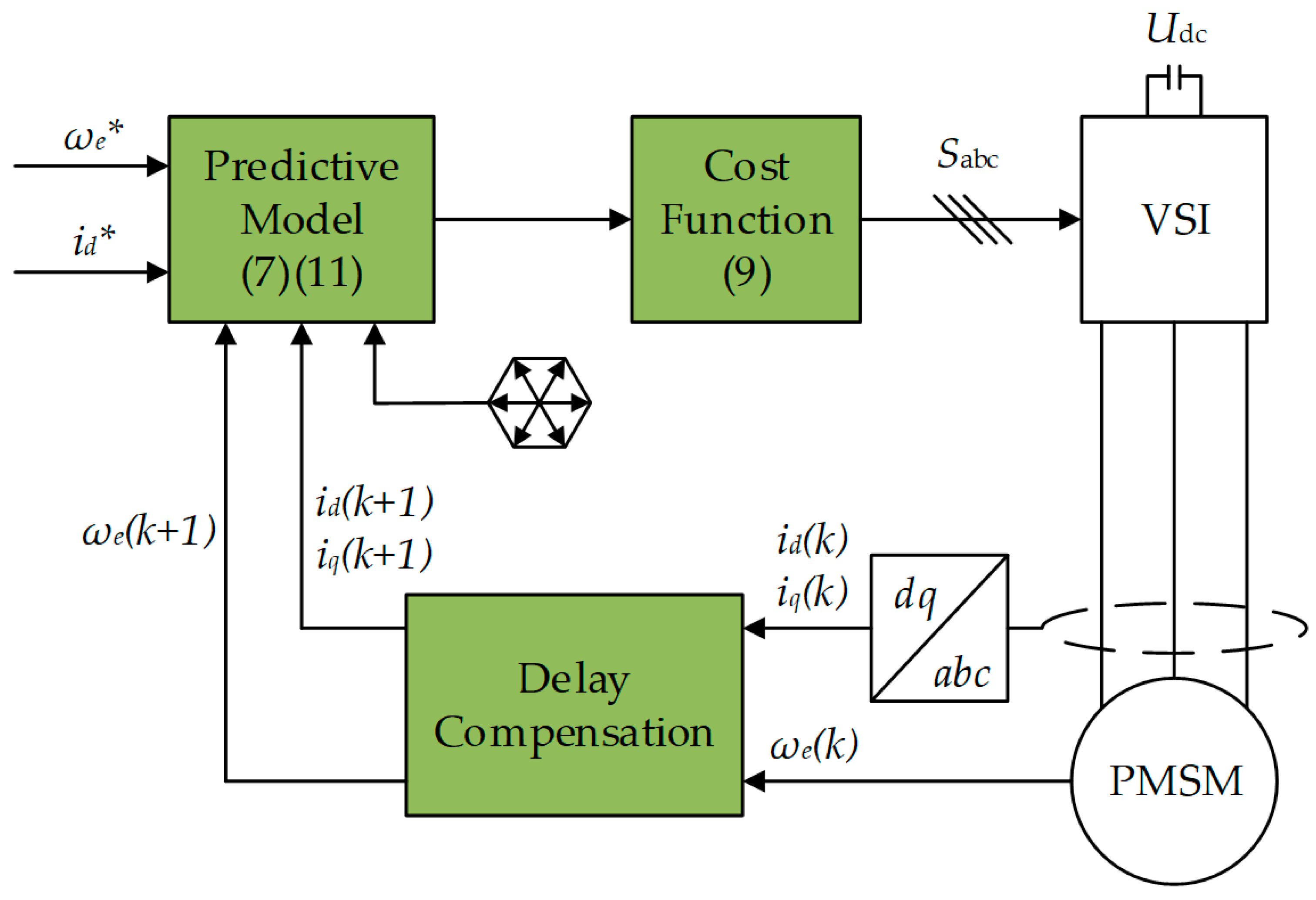
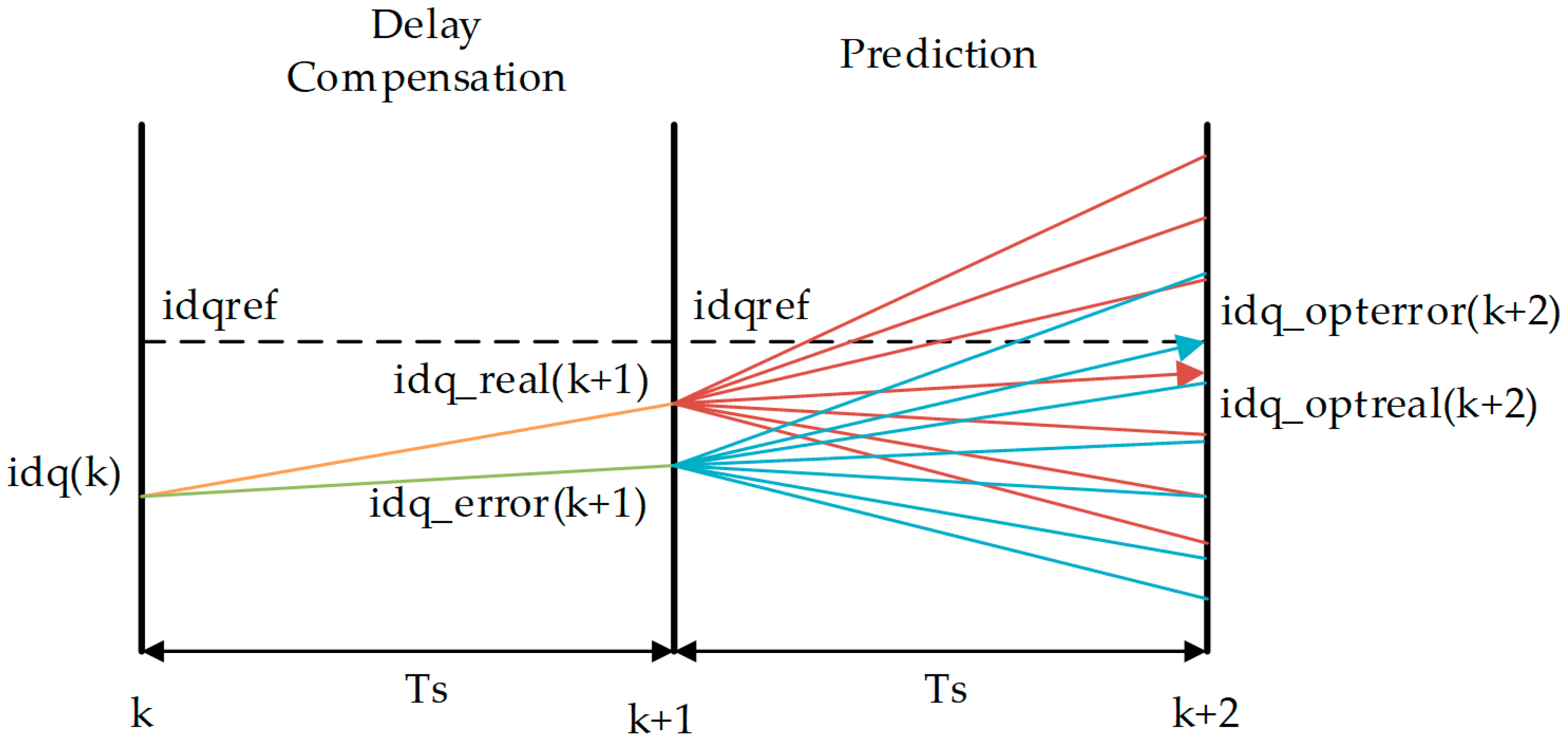
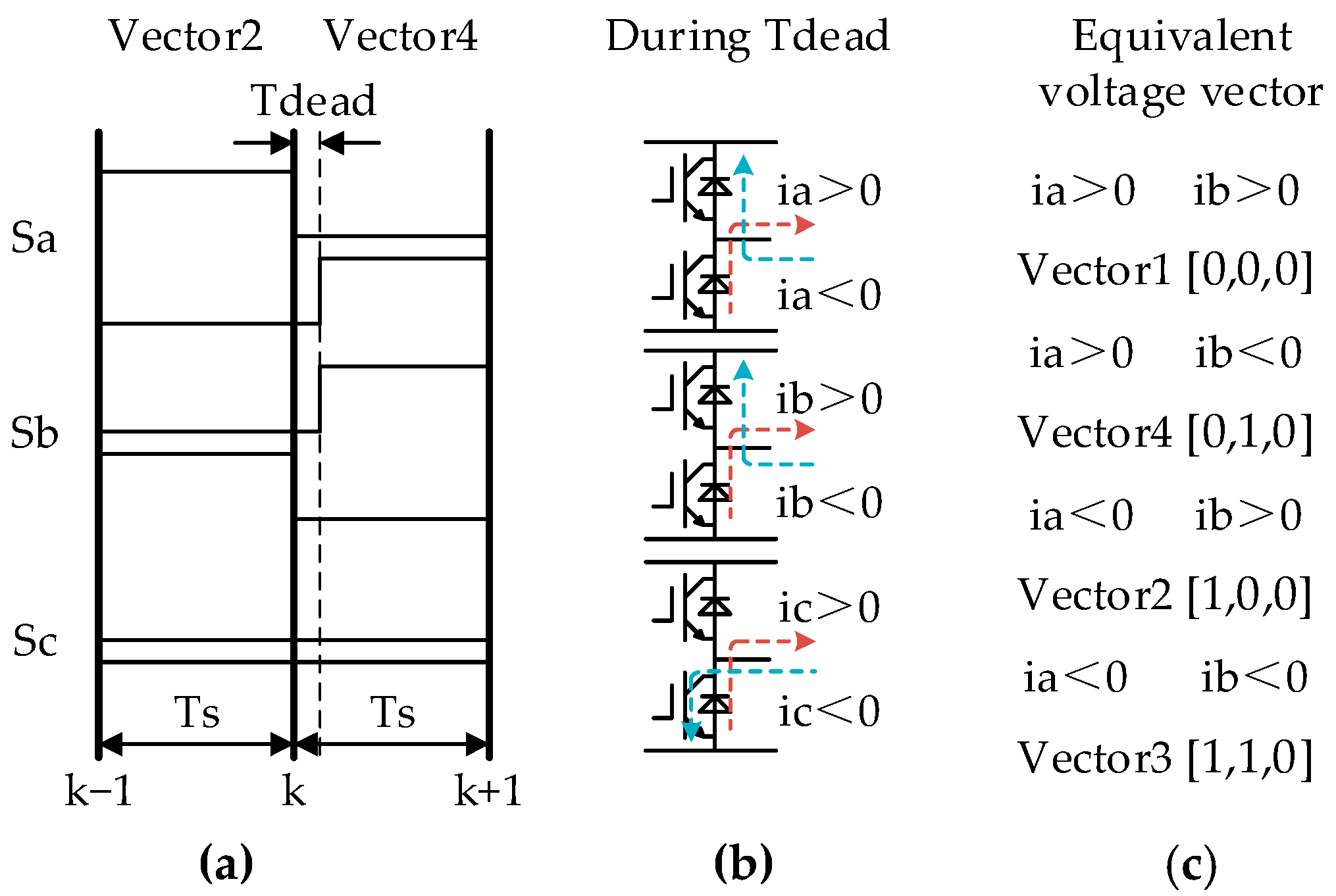
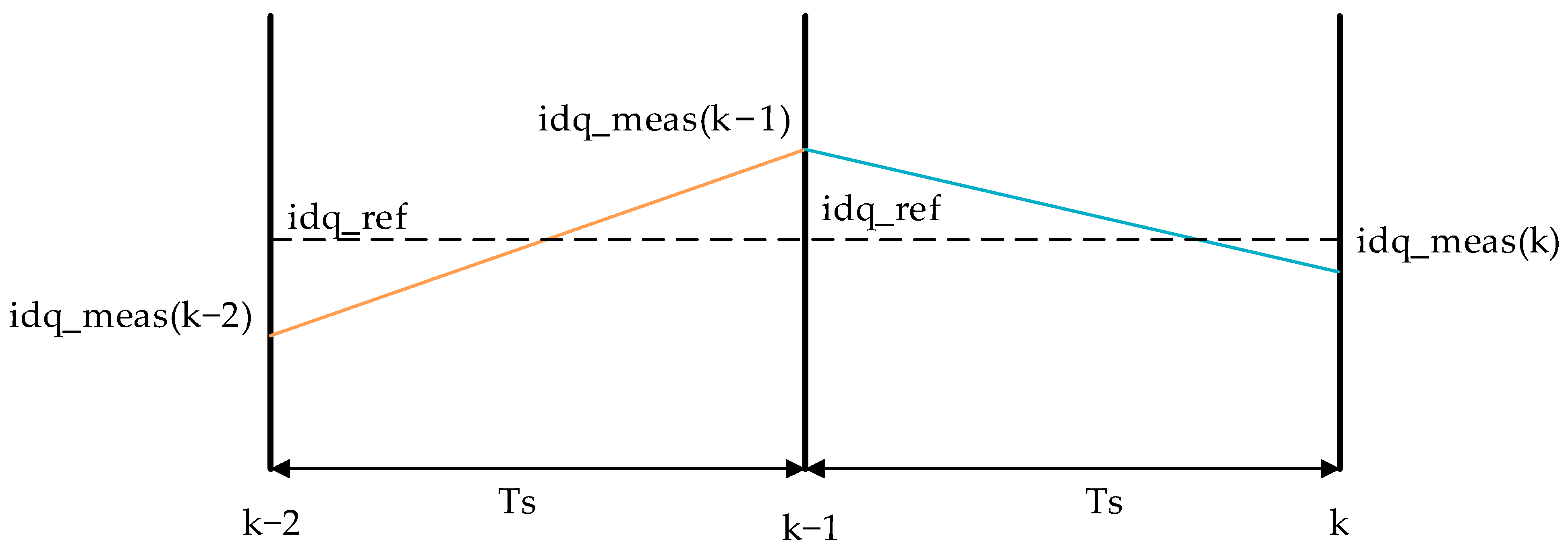
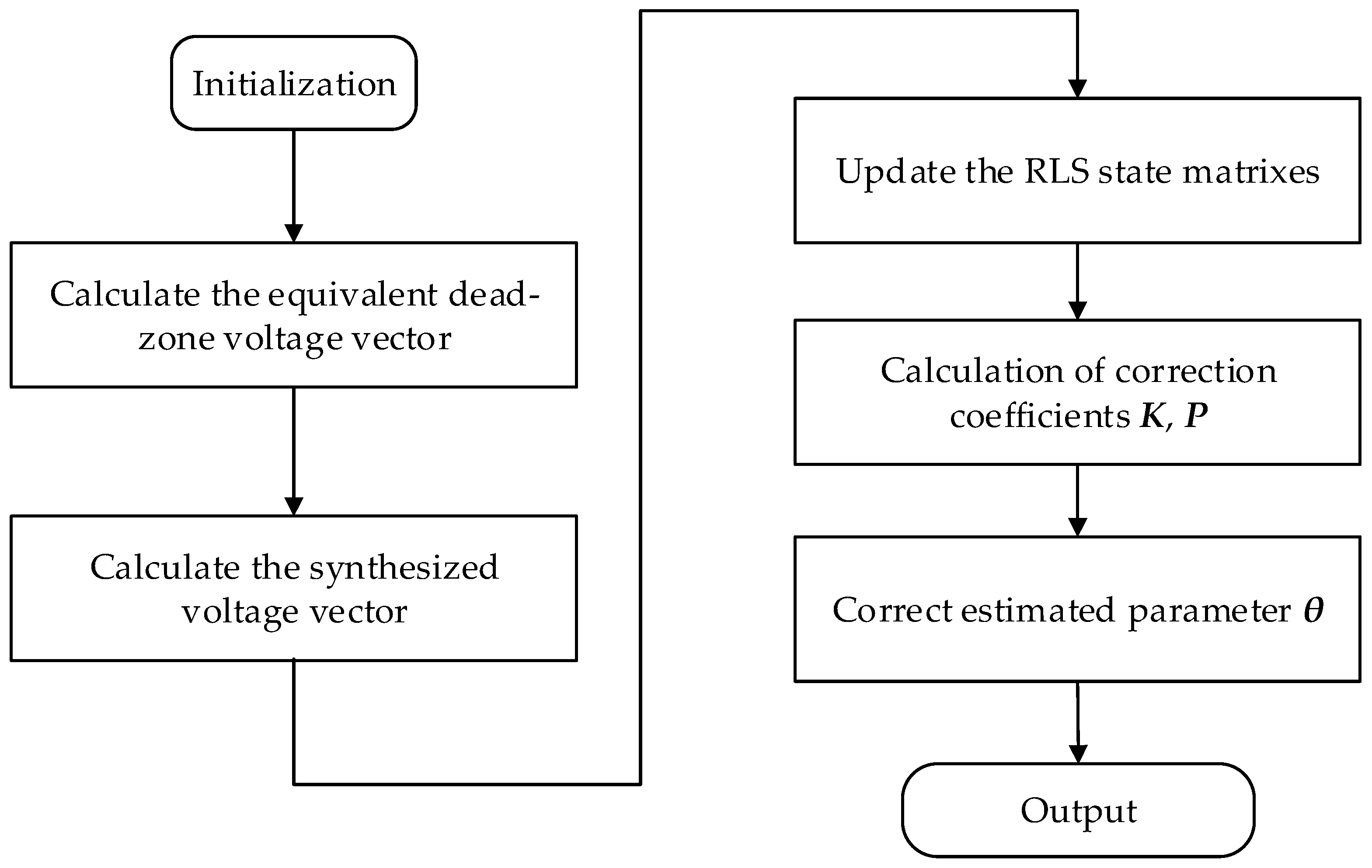
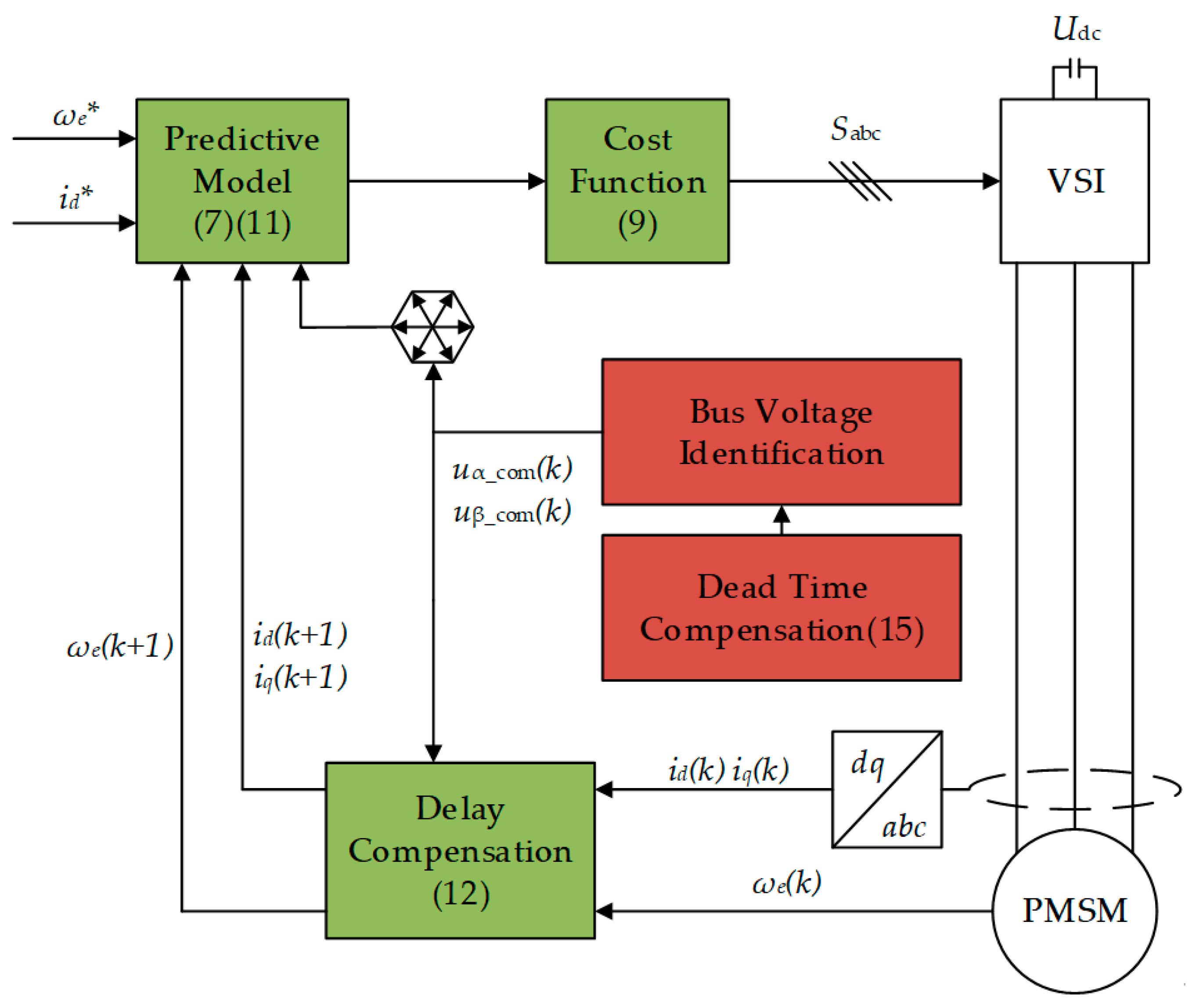
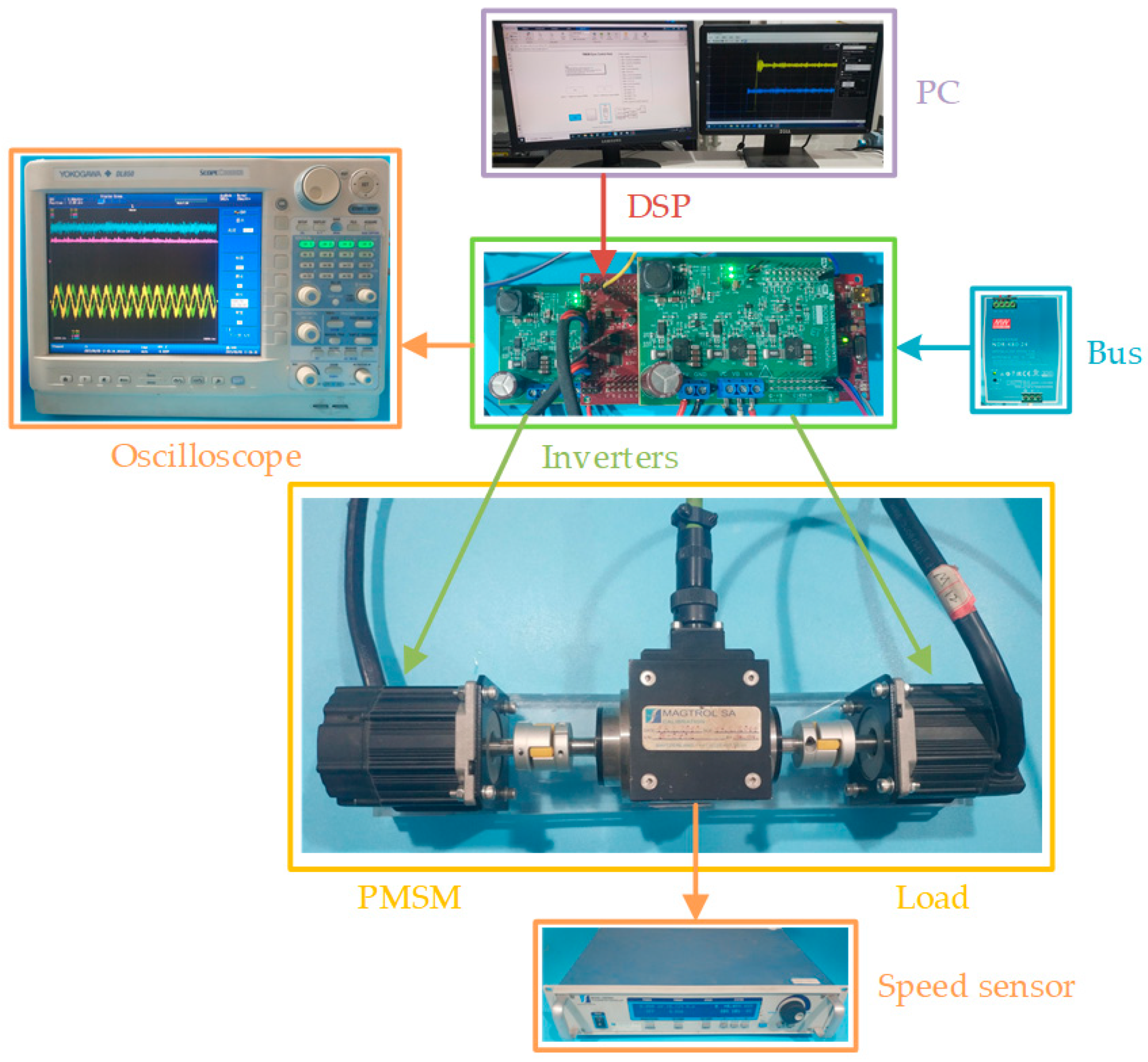
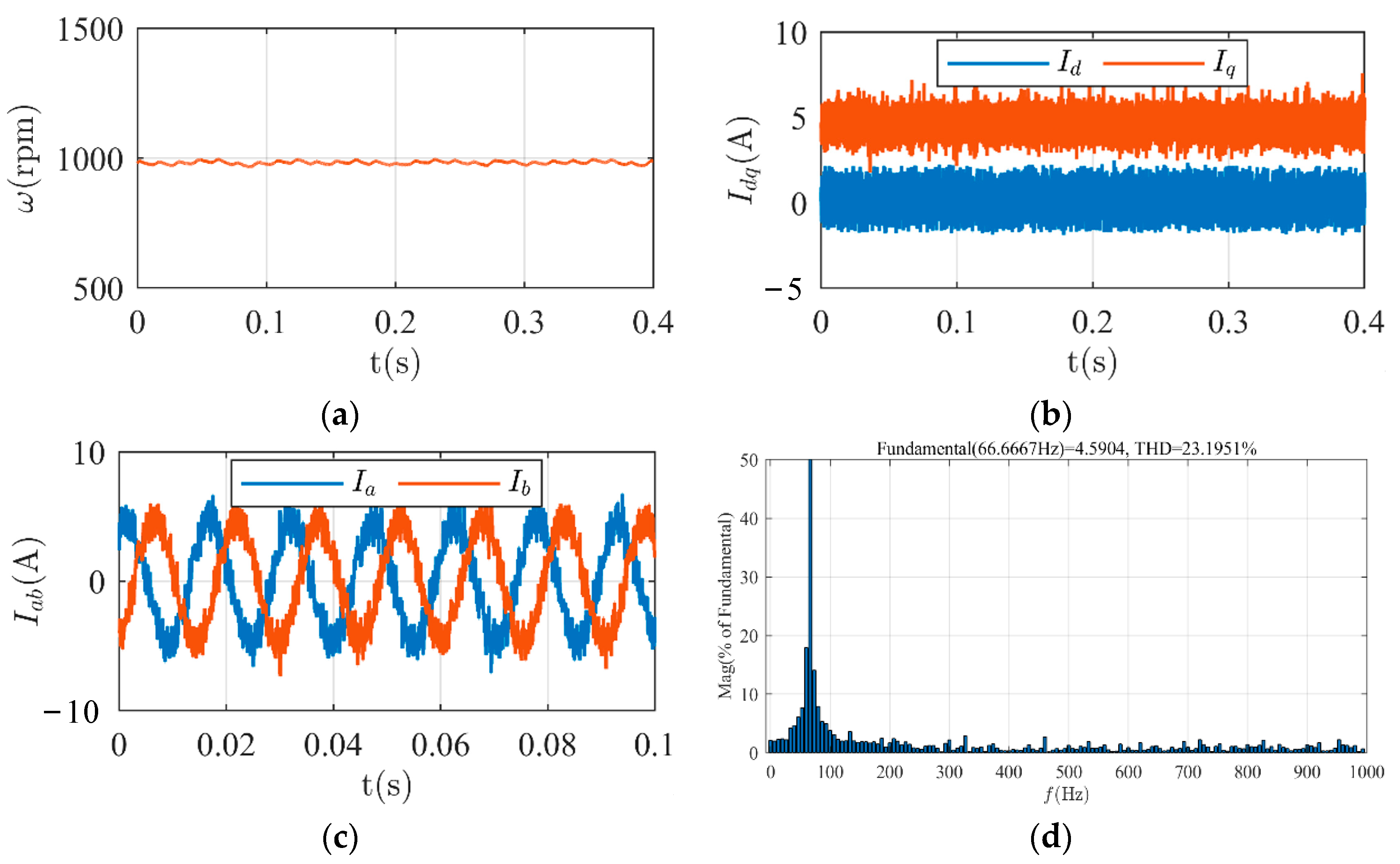

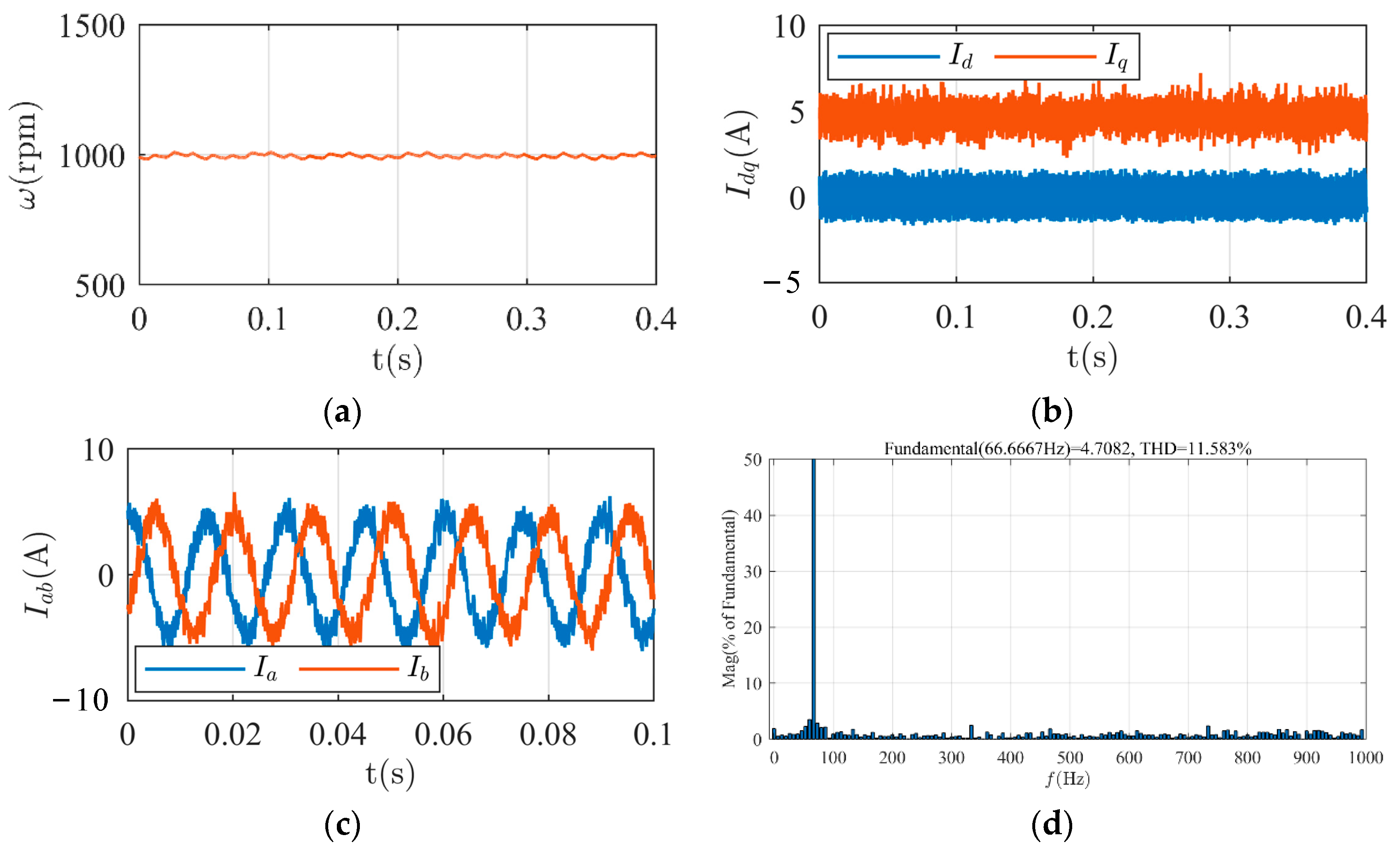


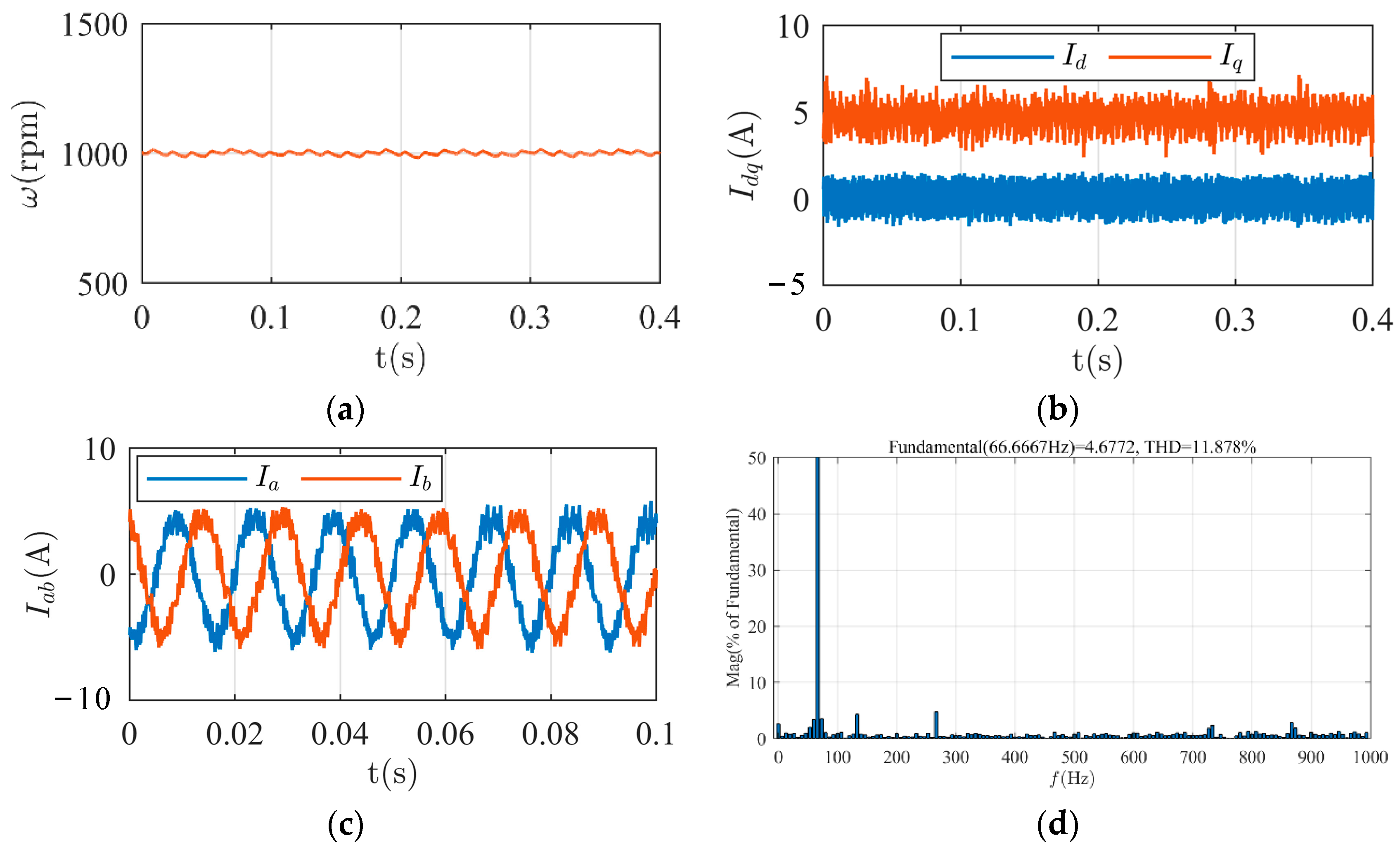
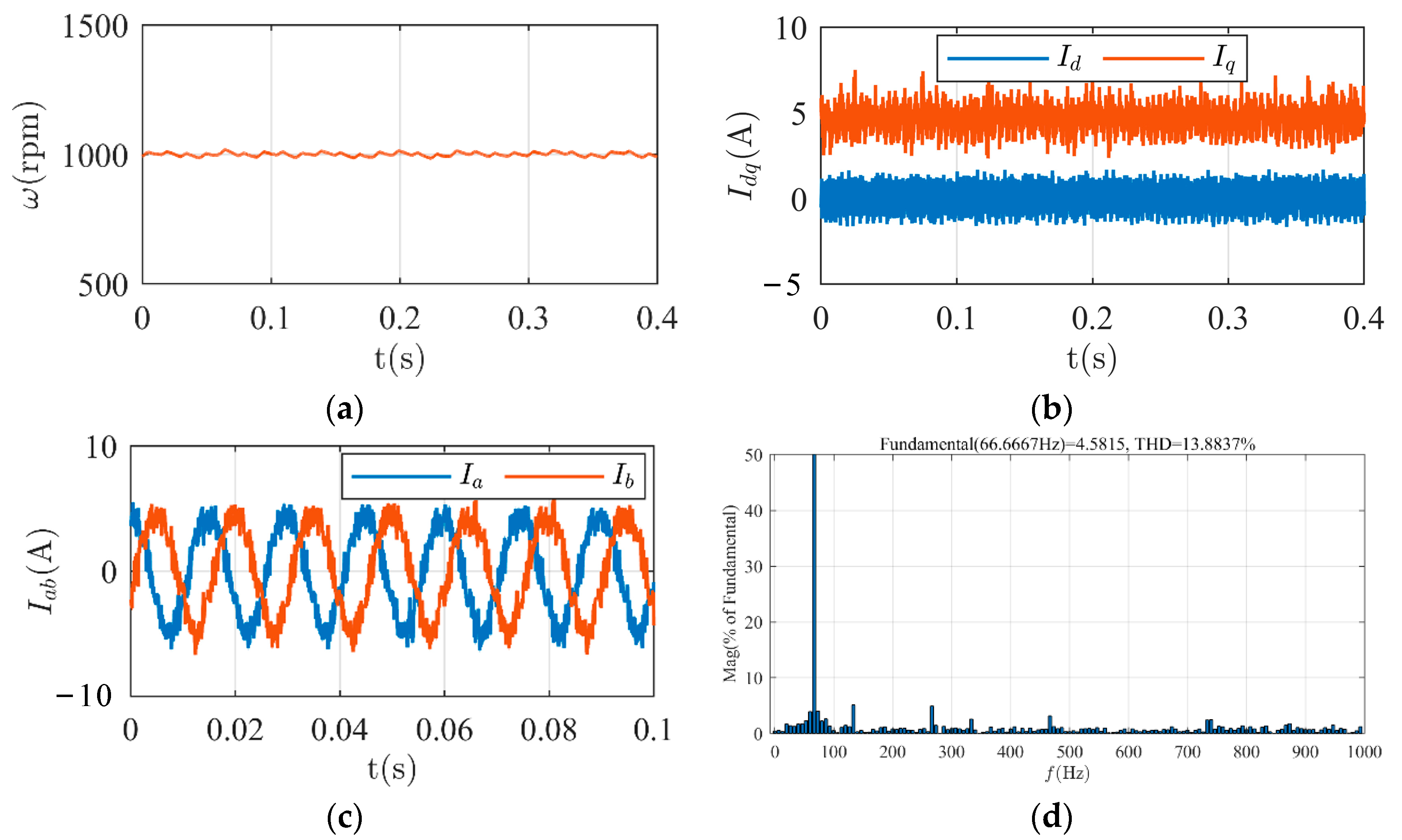
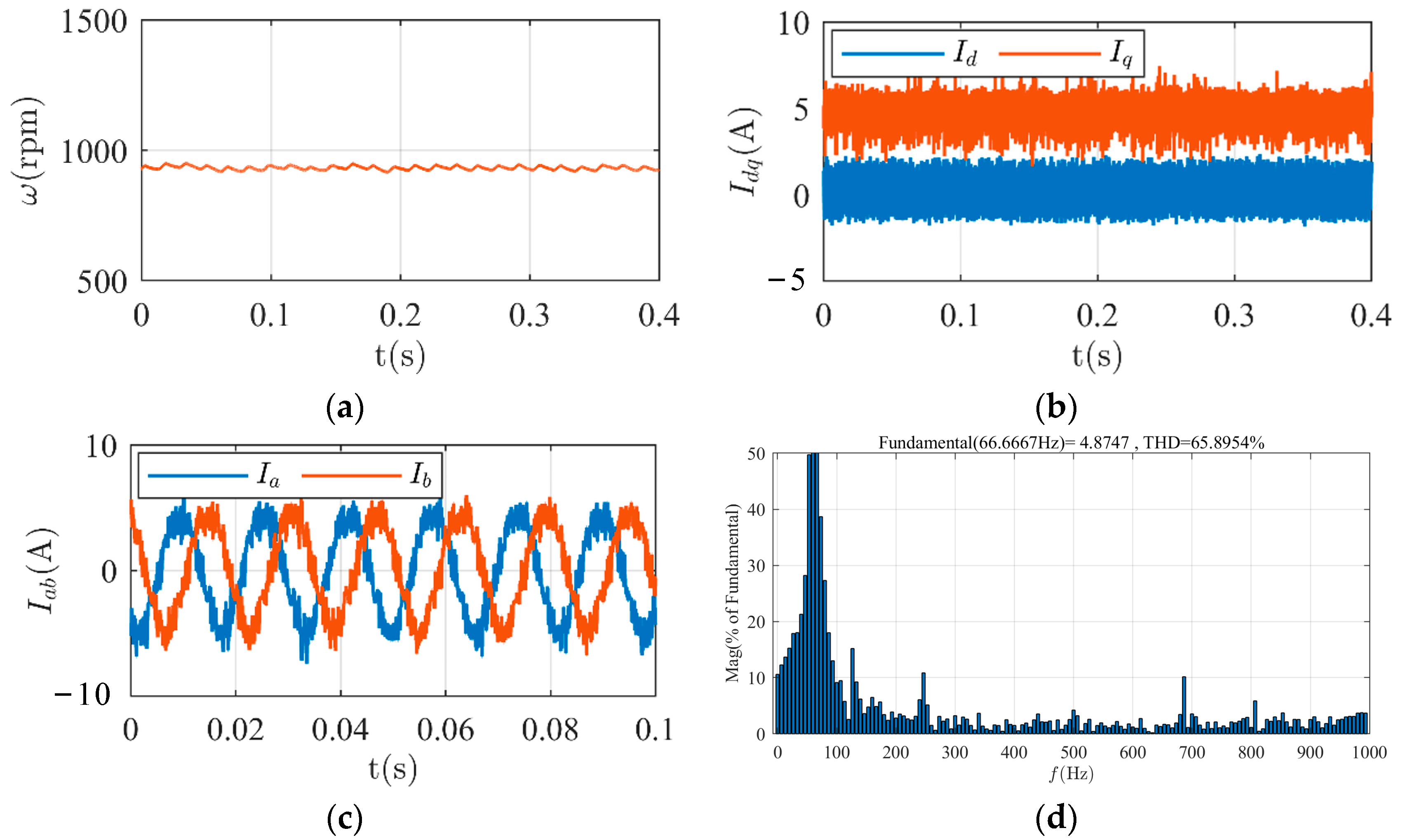


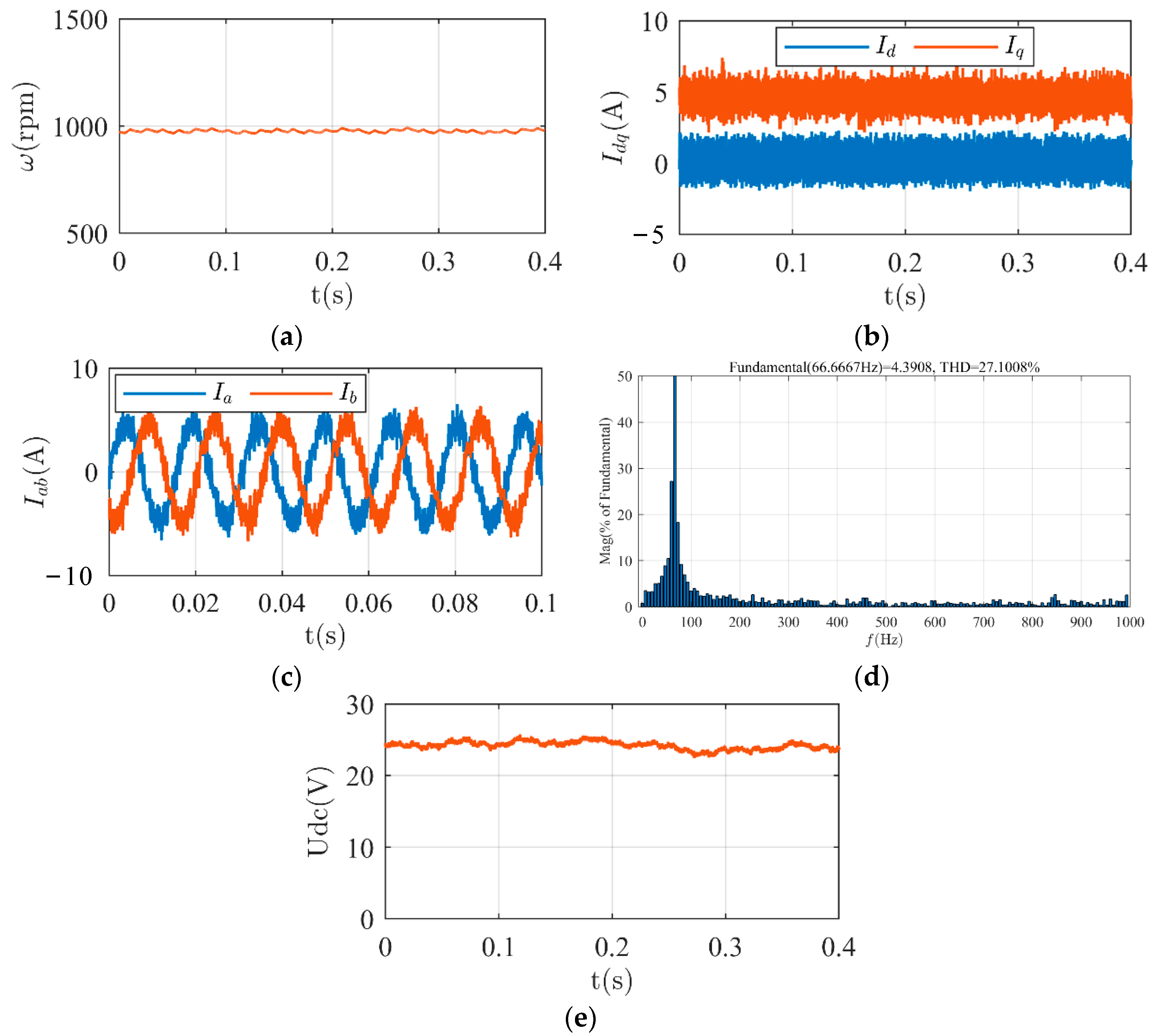
| Voltage Vector | Voltage Value |
|---|---|
| Vector 1 | |
| Vector 2 | |
| Vector 3 | |
| Vector 4 | |
| Vector 5 | |
| Vector 6 | |
| Vector 7 | |
| Vector 8 |
| Parameters | Values |
|---|---|
| p | 4 |
| Rs | 0.36 Ω |
| L | 0.2 mH |
| ψf | 0.0064 Wb |
| Udc | 24 V |
| FCS-MPDSC without VC | FCS-MPDSC with CDC | Proposed FCS-MPDSC | ||||
|---|---|---|---|---|---|---|
| Speed Error | THD of Phase Current | Speed Error | THD of Phase Current | Speed Error | THD of Phase Current | |
| Inverter Nonlinearity | 10 r/min | 23.2% | 0 | 10.1% | 0 | 11.6% |
| Bus Voltage Error | 40 r/min | 49.6% | 0 | 11.9% | 0 | 13.9% |
| Parameter Errors | 70 r/min | 65.9% | 0 | 14.1% | 30 r/min | 27.1% |
| FCS-MPDSC without VC | FCS-MPDSC with CDC | Proposed FCS-MPDSC | ||||
|---|---|---|---|---|---|---|
| 5th | 7th | 5th | 7th | 5th | 7th | |
| Inverter Nonlinearity | 2.9% | 2.7% | 1.0% | 1.3% | 1.4% | 1.7% |
| Bus Voltage Error | 7.6% | 6.0% | 1.2% | 1.6% | 1.5% | 1.9% |
| Parameter Errors | 10.1% | 8.3% | 1.7% | 2.2% | 3.4% | 3.2% |
Disclaimer/Publisher’s Note: The statements, opinions and data contained in all publications are solely those of the individual author(s) and contributor(s) and not of MDPI and/or the editor(s). MDPI and/or the editor(s) disclaim responsibility for any injury to people or property resulting from any ideas, methods, instructions or products referred to in the content. |
© 2023 by the authors. Licensee MDPI, Basel, Switzerland. This article is an open access article distributed under the terms and conditions of the Creative Commons Attribution (CC BY) license (https://creativecommons.org/licenses/by/4.0/).
Share and Cite
Gao, L.; Chai, F. Model Predictive Direct Speed Control of Permanent-Magnet Synchronous Motors with Voltage Error Compensation. Energies 2023, 16, 5128. https://doi.org/10.3390/en16135128
Gao L, Chai F. Model Predictive Direct Speed Control of Permanent-Magnet Synchronous Motors with Voltage Error Compensation. Energies. 2023; 16(13):5128. https://doi.org/10.3390/en16135128
Chicago/Turabian StyleGao, Lixiao, and Feng Chai. 2023. "Model Predictive Direct Speed Control of Permanent-Magnet Synchronous Motors with Voltage Error Compensation" Energies 16, no. 13: 5128. https://doi.org/10.3390/en16135128
APA StyleGao, L., & Chai, F. (2023). Model Predictive Direct Speed Control of Permanent-Magnet Synchronous Motors with Voltage Error Compensation. Energies, 16(13), 5128. https://doi.org/10.3390/en16135128








